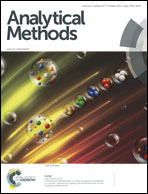Preparation of nanoporous array anodic titanium wire supported solid-phase microextraction fiber coated with a copolymerized polymerizable ionic liquid monomer pair†
Abstract
In this work, a nanoporous array anodic titanium was selected as a fiber substrate because of its high surface-to-volume ratio, easy preparation, mechanical stability, and rich titanol groups on its surface that can anchor other active groups. Then, a polymerizable ionic liquid monomer pair, (1-vinyl-3-hexadecylimidzolium)-(p-styrenesulfonate) ([C16VIm]+SS−), was synthesized and used for the chemical modification of the mercaptopropyl-functionalized nanoporous anodic titania support using a surface radical chain-transfer addition. A homogeneous and porous coating with a thickness of about 7 μm was achieved. The main advantage of this copolymerization method over the conventional single-ion polymerization is its high stability under harsh conditions, like high temperatures, as well as acidic, alkaline and high ionic strength solutions. Combined with gas chromatography-a flame ionization detection (GC-FID), the poly[C16VIm]+SS− was used as a sorbent material for the direct immersion SPME of four types of compounds, including polycyclic aromatic hydrocarbons, hydrophobic phenols, non-volatile phthalate esters and parabens, in an aqueous solution. The analytical performance of the proposed method was investigated under the optimum extraction conditions (content of NaCl, 20% (w/v); extraction temperature, 70 °C; and extraction time, 55 min). Calibration ranges were 0.1–400 μg L−1 for four hydrophobic phenols, anthracene (Ant) and fluoranthene (Flt), 0.15–600 μg L−1 for dibutyl phthalate (DBP) and di-(2-ethyl-hexyl) phthalate (DEHP), and 0.5–2000 μg L−1 for ethylparaben (EPN) and propylparaben (PPN). The as-established method showed good linearity with good correlation coefficients (R = 0.993–0.999) and low detection limits in the range of 0.003 to 0.156 ng mL−1 (S/N = 3). In addition, the poly[C16VIm]+SS−-SPME fiber showed good precision (3.2–13.5%) and repeatability between fiber and fiber (9.1–19.6%). Finally, soil extract sample were analyzed and satisfactory results were obtained.


 Please wait while we load your content...
Please wait while we load your content...